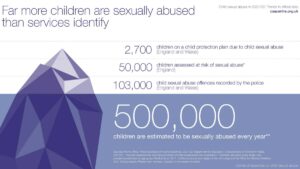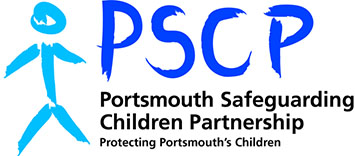Child Sexual Abuse
Working Together to Safeguard Children 2018 defines sexual abuse as:
“forcing or enticing a child or young person to take part in sexual activities, not necessarily involving a high level of violence, whether or not the child is aware of what is happening. The activities may involve physical contact, including assault by penetration (for example, rape or oral sex) or non-penetrative acts such as masturbation, kissing, rubbing and touching outside of clothing. They may also include non-contact activities, such as involving children in looking at, or in the production of, sexual images, watching sexual activities, encouraging children to behave in sexually inappropriate ways, or grooming a child in preparation for abuse. Sexual abuse can take place online, and technology can be used to facilitate offline abuse. Sexual abuse is not solely perpetrated by adult males. Women can also commit acts of sexual abuse, as can other children.”
Child sexual abuse (CSA) is referred to as either being recent if it occurred within the previous 7 days, or as non-recent in that it occurred within the previous few weeks, months or years. Our response to the child should be the same regardless, the only difference being that in recent abuse the police may request forensic sampling from a child protection medical by a specialist CSA regional centre
Research indicates that just one in three children who had been sexually abused by an adult told anyone. For those abused by another child this was even less, with five out of six not speaking to anyone. This may be because:
- Children often do not talk about sexual abuse because they think it is their fault or they have been convinced by their abuser that it is normal or a “special secret”.
- Children may also be bribed or threatened by their abuser or told they will not be believed.
- A child who is being sexually abused may care for their abuser and worry about getting them into trouble.
However children may show other emotional, behavioural and physical signs of their abuse. Here are some of the signs you may notice:
- Changes in behaviour – a child may start being aggressive, withdrawn, clingy, have difficulties sleeping, have regular nightmares or start wetting the bed.
- Avoiding the abuser – the child may dislike or seem afraid of a particular person and try to avoid spending time alone with them.
- Sexually inappropriate behaviour – children who have been abused may behave in sexually inappropriate ways or use sexually explicit language.
- Physical problems – the child may develop health problems, including soreness in the genital and anal areas or sexually transmitted infections, or they may become pregnant.
- Problems at school – an abused child may have difficulty concentrating and learning, and their grades may start to drop.
- Giving clues – children may also drop hints and clues that the abuse is happening without revealing it outright.
The Centre of Expertise on Child Sexual Abuse has developed a Signs & Indicators Template using practical evidence-based guidance. Use of this can provide a common language amongst professionals to discuss, record and share concerns that a child is being, or has been sexually abused.

For more information please visit Infographics – CSA Centre
It is important to consider the details of the disclosure by a child of sexual abuse; very often the child will report the abuse days, weeks or months after it has happened. However, when reporting child sexual abuse, timeframes are crucial for the professionals undertaking an assessment or investigating so that the child experiences an appropriate response. Please refer to this guide on Reporting Child Sexual Abuse
Worried about a child – If you are concerned that a child or young person has suffered harm, neglect or abuse, please contact Portsmouth Multi Agency Safeguarding Hub (MASH)
If a child is at immediate risk of harm, call the Police on 999.
- The Brook’s Sexual Behaviours Traffic Light Tool is useful in to enabling practitioners to effectively identify, assess and support children who may be displaying sexual behaviours. The training and accompanying tool equip professionals to make consistent and informed decisions that neither stigmatise nor criminalise young people. Participants will learn about healthy sexual development, understand key laws relating to sexual behaviour and gain knowledge on enabling robust and meaningful conversations around harmful sexual behaviours that cause concern. The cost of this training starts from £30 / person: Traffic Light Tool Course
- NSPCC has produced a guide to help you decide what kind of sexualised behaviour a child or young person is displaying so you can respond in the right way: Understanding sexualised behaviour in children
- The Child Sexual Abuse Toolkit has been developed by Hampshire, Isle of Whight, Portsmouth & Southampton (HIPS) Safeguarding Children Partnerships. This toolkit has been produced to support a coordinated approach to preventing child sexual abuse and improve identification, protection and support for victims, survivors and their families. It has been created to improve the ways in which children’s needs and risks are understood, recognised and responded to.
- Medical assessments for children are child-friendly and child-led. They should be considered in all instances of suspected child sexual abuse where direct contact may have occurred. They are provided to address health needs, reassure children and their families, answer health questions, address wider medical safeguarding needs and sometimes to provide forensic information e.g. by detection of injuries or on external swabs to look for DNA. It is important that children are referred as soon as possible after disclosure (same day where possible). Referrals for a specialist medical can be made only via police or children’s services. Paediatricians are happy to advise professionals.
Please see the links below for contact details and pathways, referral forms and patient leaflets:
- Guide to medical examinations in suspected child sexual abuse (CSA)
- HIPS pathway for pregnancy in children under the age of 13
- HIPS child protection medical request form
- CSA medical leaflet for children and carers
- eLearning – CSA Centre
- PSCP provides training on the Process for Safeguarding Medical Examinations – PSCP Training. Please request a password to access this training pscptraining@portsmouthcc.gov.uk
Sexual Health & Wellbeing – Brook – Fighting for healthy lives
Centre of expertise on child sexual abuse provides a range of useful guidance resources, including:
- Managing risk and trauma after online sexual offending
- Helping education settings identify and respond to concerns
- Sibling sexual abuse and behaviour
- Supporting practice in tackling child sexual abuse
- Signs and indicators template
- Communicating with children guide
- Supporting parents and carers guide
- Medical Examinations
Understanding sexualised behaviour in children | NSPCC Learning
